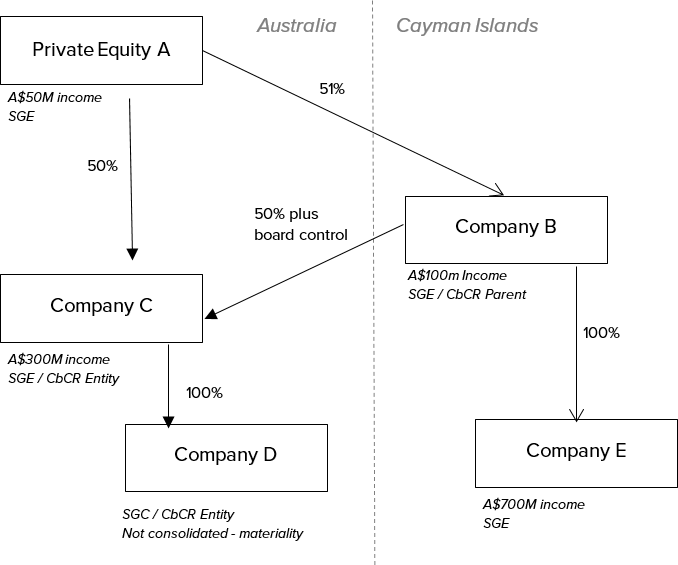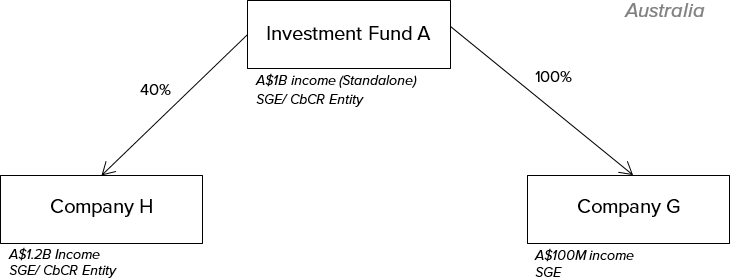This article was originally published 18 June 2020.
On 25 May 2020, Royal Assent was granted to Treasury Laws Amendment (2020 Measures No.1) Bill 2020 (the Bill). The Bill broadens the Significant Global Entity (SGE) definition and introduces the concept of a Country-by-Country Reporting Entity (CbCR Entity).
The Bill will significantly broaden the number of entities defined as SGEs. New SGEs will include entities with collective turnover greater than A$1 billion that are owned by pension funds, private equity investors and individuals.
Additional legislation and significantly increased penalties will apply to these new SGEs, meaning the passage of the Bill will greatly increase the Australian Taxation Office’s (ATO’s) powers to challenge the tax arrangements of these new SGEs, combined with a sharp increase in the consequences of any non-compliance.
Are you a SGE under the new legislation?
It is crucial entities assess whether the Bill applies to them, as SGEs are subject to significantly increased penalties and additional legislation. For example, entities meeting the new SGE definition are subject to the multilateral anti-avoidance law (MAAL), the diverted profits tax (DPT), and increased penalties where applicable. The penalties in particular can be significant, for example, the administrative penalties for late lodgement of tax-related documents by SGEs start at $111,000 and can increase to $555,000 per document.
Under the previous definition, a SGE was a global parent entity or member of a group of entities that had consolidated for accounting purposes and had an annual global income of at least A$1 billion for all members of the group (consolidated).
Under the new definition, an SGE will include entities considered a Notional Listed Company Group (NLCG). An NLCG is broadly a group of entities required to consolidate as a single accounting group for accounting purposes, if a member of the group was a listed company and exceptions to requirements to consolidate were disregarded (including materiality and investment entity exemptions).
In determining whether an entity is “required to consolidate”, and potentially classified as an SGE, reference should be made to whether it “controls” the entity or entities in question, as defined in AASB 10. This determination should also consider other factors, including, but not limited to, the ownership percentage, composition of directors and shareholder agreement. Given the subjectivity in the determination of control, unless there is ownership by one party of greater than 50% of another entity, the review of whether there is sufficient control to form an NLCG will require professional judgement and will have to be performed on a case-by-case basis. Importantly, the process of assessing control and evidence of the conclusion should be carefully considered and documented. The consequences of reaching the wrong conclusion, and therefore not complying with additional compliance obligations, could be significant.
Examples of entities that may be considered an SGE under the new law (this is not an exhaustive list) include:
- Entities headed by individuals, partnerships, trusts, private companies and investment companies that are considered an NLCG
- Entities not currently consolidated in global accounts due to size (materiality)
- Entities not required by law to prepare accounts (i.e. privately owned entities or entities owned through trusts).
If you are an SGE, are you also a Country-by-Country Reporting Entity?
With the new definition of SGEs also comes a new reporting category for Country-by-Country Reporting Entities (CbCR entities). CbCR Entities face additional compliance requirements over and above those that apply to all SGEs, such as the requirement to lodge annual General Purpose Financial Statements (GPFS) and Country-by-Country reporting statements with the ATO. For taxpayers who were historically a SGE, little will change from a practical perspective as they will still be CbCR Entities, and most new SGEs are unlikely to be CbCR Entities (except those previously excluded due to materiality).
The introduction of the CBCR Entity definition intends to ensure not all SGEs have an obligation to submit Country-by-Country Reporting Documents (i.e. CbC Report, Master File and Local File) and align Australia’s legislation with international standards.
Given there are differences in the determination of SGEs and the CbCR Entity classification, but potential overlap between the two concepts, we note that a CbCR Entity will always be a subset of an SGE, however, not all SGEs will be CbCR Entities.
This is an important distinction, as all SGEs are subject to the increased penalties, increased tax and transfer pricing scrutiny, and anti-avoidance legislation specifically targeted at large multinationals. The new SGE definition is designed to bring more multinational companies into relevant Australian integrity and penalty provisions. CbCR Entities will also immediately have additional compliance requirements, and that definition is more aligned to the SGE definition used by other countries.
Below is a high-level summary of the different obligations and penalties.
|
|
GPFS obligations |
CbC reporting |
DPT/ MAAL |
Late lodgement penalties |
False/ misleading |
Penalties as a result of a transfer pricing adjustment |
Other administrative penalties |
|
SGE |
X |
X |
✓ |
✓ |
✓ |
✓ |
✓ |
|
CbCR Entity |
✓ (added to legislation) |
✓ (added to legislation) |
n/a |
n/a |
n/a |
n/a |
n/a |
In summary, if an entity is both an SGE and a CbCR Entity, it will be subject to both multinational anti-avoidance measures and the increased compliance requirements described above. If it is an SGE but not a CBCR Entity, only the DPT/MAAL and increased scrutiny and penalty measures will apply.
The new requirements to determine whether an SGE is also a CbCR Entity are complex and must be assessed on a case-by-case basis by considering specific facts and circumstances. We recommend this assessment be undertaken for all potential new SGEs, as well as for existing SGEs that previously did not have additional compliance requirements (for example, where a subsidiary was immaterial in the Group context).
Given the complexity of definitions, we have provided worked examples to help you understand them in more detail.
Worked examples of how the revised Significant Global Entity (SGE) Bill is applied
Example 1
Application of the new legislation
SGE
Private Equity A controls Company B, which in turns controls Companies C, D and E. Company C controls Company D. The combined global annual income of controlled companies is in excess of A$1 billion.
Given the 51% ownership in Company B, had Private Equity A been a listed company and exceptions to requirements to consolidate been disregarded, the entities would be required to consolidate as a single group for accounting purposes. Similarly for Company D, despite not being consolidated on the grounds of materiality, it would still be required to consolidate as exceptions are disregarded.
As such, all companies will together form a Notional Listed Company Group (NLCG) and fall within the revised definition of SGE, in Australia. The increased penalties and specific anti-avoidance laws would apply.
Country-by-Country Reporting (CbCR) Entity
Private Equity A does not form part of the Country-by-Country Reporting Group, as the exception to the requirement to consolidate is taken into account when working out the entities that form part of the CbCR Group.
Private Equity A will not be a CbCR Entity as its standalone annual income is below A$1 billion. Companies B, C, D and E will form a CbCR Group, with Company B as the CbCR Parent because:
- It is a group of entities that would be required to consolidate for accounting purposes as a single group if a member of such group was listed
- The materiality exception is disregarded
- The CbCR Group’s consolidated global annual income is more than A$1 billion.
The additional compliance requirements (i.e. need to lodge CbCR statements and General Purpose Financial Statements) will also apply.
Example 2
Application of the new legislation
SGE
Investment Fund A controls 40% of Company H and 100% of Company G. The combined annual income of the controlled companies is in excess of A$1 billion.
To determine whether Company H will form part of the NLCG, an assessment of whether Investment Fund A has control over Company H will need to be undertaken to work out if it is required to be consolidated.
Investment Fund A is not required to consolidate Company G due to Investment Entity exemption. If Investment Fund A was a listed company and exceptions to requirements to consolidate were disregarded, Company G would have been consolidated.
Assuming Company H is not required to be consolidated, Investment Fund A and Company G will together form an NLCG and fall within the SGE definition (as combined annual income is in excess of A$ 1 billion).
CbCR Entity
Investment Fund A, Company G and Company H do not form part of the CbCR Group as the exception to the requirement to consolidate for investment entities is taken into account when working out the entities that form part of the CbCR Group.
Investment Fund A will be a CbCR Parent and a CbCR Group on its own because its standalone annual income is A$1 billion and it is not controlled by another entity in the CbCR Group.
Company H will form a CbCR Group and be a CbCR Parent on its own because its standalone annual income is more than A$1 billion.
Company G will not be a CbCR Entity as its standalone income is less than A$1 billion.
When do the new rules apply?
The amendments will apply to income years starting on or after 1 July 2019. As a transitional measure, penalties that could arise from the amendments do not apply until 1 July 2020 for entities that were not previously SGEs.
What does this mean for you?
More entities will be caught under the new SGE definition and subject to increased compliance obligations, stricter penalties and a higher risk of ATO review of their tax affairs.
The level of transfer pricing scrutiny and risk for these entities will also increase significantly, given that a lot of SGE targeted measures were originally introduced to ensure multinational companies pay their ‘fair share’ of tax in Australia.
The impact of the revised definition will often require a detailed assessment on a case-by-case basis. We encourage you to contact your BDO adviser if you think you may be affected by the change, or if you are unsure whether the new changes will apply to your entity.

